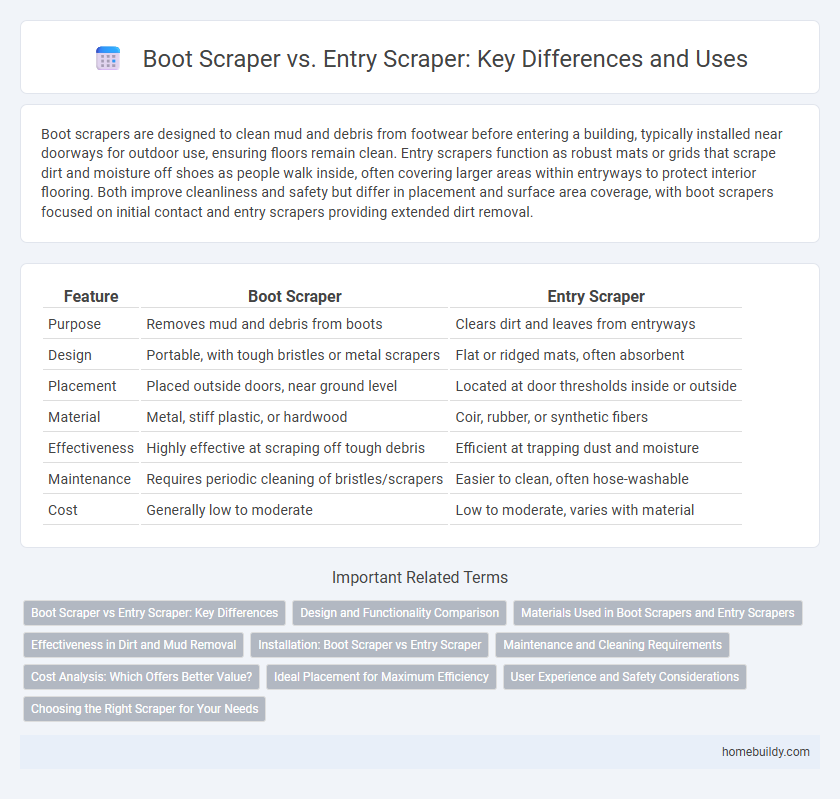Boot scrapers are designed to clean mud and debris from footwear before entering a building, typically installed near doorways for outdoor use, ensuring floors remain clean. Entry scrapers function as robust mats or grids that scrape dirt and moisture off shoes as people walk inside, often covering larger areas within entryways to protect interior flooring. Both improve cleanliness and safety but differ in placement and surface area coverage, with boot scrapers focused on initial contact and entry scrapers providing extended dirt removal.
Table of Comparison
| Feature | Boot Scraper | Entry Scraper |
|---|---|---|
| Purpose | Removes mud and debris from boots | Clears dirt and leaves from entryways |
| Design | Portable, with tough bristles or metal scrapers | Flat or ridged mats, often absorbent |
| Placement | Placed outside doors, near ground level | Located at door thresholds inside or outside |
| Material | Metal, stiff plastic, or hardwood | Coir, rubber, or synthetic fibers |
| Effectiveness | Highly effective at scraping off tough debris | Efficient at trapping dust and moisture |
| Maintenance | Requires periodic cleaning of bristles/scrapers | Easier to clean, often hose-washable |
| Cost | Generally low to moderate | Low to moderate, varies with material |
Boot Scraper vs Entry Scraper: Key Differences
Boot scrapers are designed specifically to remove mud and debris from boots before entering a building, featuring sturdy metal or cast iron construction with rigid scraping edges. Entry scrapers serve a broader purpose by cleaning various footwear types at entryways, often incorporating absorbent mats alongside scraping surfaces to capture finer dirt and moisture. The key difference lies in boot scrapers' specialized focus on heavy-duty boot cleaning, while entry scrapers provide versatile, all-footwear cleaning solutions for general use.
Design and Functionality Comparison
Boot scrapers typically feature robust, angled metal blades designed for scraping mud and dirt off footwear, emphasizing durability and outdoor suitability. Entry scrapers often have softer bristles or mats aimed at trapping fine particles and moisture to protect indoor flooring, prioritizing cleanliness and ease of maintenance. The design difference reflects their functionality: boot scrapers withstand harsh external conditions, while entry scrapers enhance indoor cleanliness through gentle, effective debris removal.
Materials Used in Boot Scrapers and Entry Scrapers
Boot scrapers are typically crafted from durable materials like cast iron, steel, or wrought iron to withstand outdoor exposure and heavy use, ensuring effective removal of mud and debris from footwear. Entry scrapers often incorporate materials such as rubber, coir, or synthetic fibers that offer flexibility and enhanced dirt trapping for indoor use. The material choice directly affects the scraper's durability, cleaning efficiency, and suitability for either exterior or interior installation.
Effectiveness in Dirt and Mud Removal
Boot scrapers excel in removing heavy dirt and stubborn mud from boots due to their sturdy metal or brush design, which effectively cleans deep treads and crevices. Entry scrapers, while convenient for quick surface cleaning, often miss embedded debris in rugged footwear, making them less effective for thorough dirt removal. For high-performance cleaning in muddy environments, boot scrapers offer superior durability and efficiency compared to entry scrapers.
Installation: Boot Scraper vs Entry Scraper
Boot scrapers are typically installed at ground level near doorsteps, requiring minimal anchoring for effective mud and debris removal from footwear. Entry scrapers are mounted directly in entryway thresholds or integrated into door mats, designed for comprehensive debris capture before entering indoor spaces. Installation of boot scrapers is straightforward and outdoor-focused, while entry scrapers demand precise fitting and indoor placement for optimal performance.
Maintenance and Cleaning Requirements
Boot scrapers typically require less frequent maintenance due to their simpler design and sturdy materials such as cast iron or stainless steel, which resist rust and wear. Entry scrapers, designed with multiple layers or mats, demand regular cleaning to prevent dirt buildup and maintain effectiveness, often necessitating vacuuming or washing. Consistent upkeep of entry scrapers ensures optimal dirt removal at doorways, whereas boot scrapers benefit from occasional debris removal and inspection for damage.
Cost Analysis: Which Offers Better Value?
Boot scrapers typically involve lower initial installation costs compared to entry scrapers due to simpler design and materials, making them cost-effective for basic mud and debris removal. Entry scrapers, while more expensive upfront, offer advanced features like integrated brushes and drainage systems, providing better durability and reduced maintenance costs over time. Evaluating the long-term return on investment, entry scrapers often deliver better value for high-traffic commercial properties, whereas boot scrapers suit budget-conscious residential applications.
Ideal Placement for Maximum Efficiency
Boot scrapers should be installed near the main entrance, ideally at ground level where foot traffic is highest, to capture dirt and debris before entering the building. Entry scrapers, designed for indoor use, perform best when placed just inside doorways on durable mats or grates, ensuring maximum dirt retention and floor protection. Optimal placement of both devices reduces cleaning frequency and maintains indoor cleanliness by targeting contaminants at key transition points.
User Experience and Safety Considerations
A boot scraper offers enhanced user experience by efficiently removing mud and debris from footwear, reducing indoor dirt and slip hazards compared to entry scrapers designed primarily for surface dirt. Boot scrapers are typically sturdier with sharp scrubbing edges, ensuring safer and cleaner entry, which minimizes the risk of soil tracking and potential falls. For high-traffic entryways, boot scrapers provide superior durability and effectiveness, promoting a safer, cleaner environment.
Choosing the Right Scraper for Your Needs
Selecting the appropriate scraper depends on the specific application, as boot scrapers are designed to efficiently remove mud and debris from footwear, ideal for outdoor use or muddy environments. Entry scrapers typically combine functionality with aesthetic appeal, suitable for residential or commercial doorways where both cleanliness and decorative value are important. Evaluate the durability, design, and installation location to ensure the scraper meets your practical requirements and complements the entry area.
Boot scraper vs Entry Scraper Infographic

 homebuildy.com
homebuildy.com